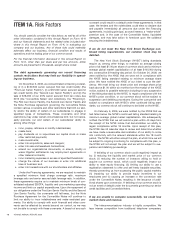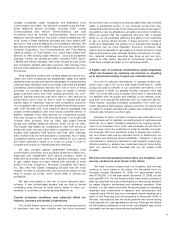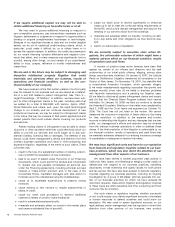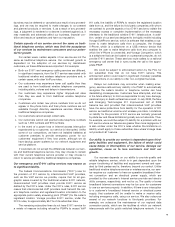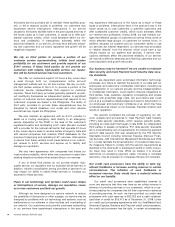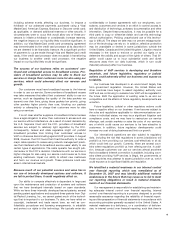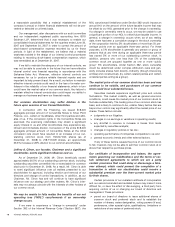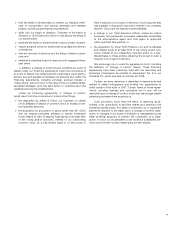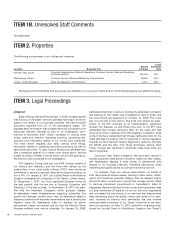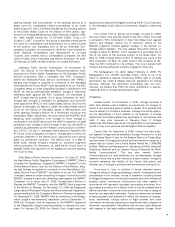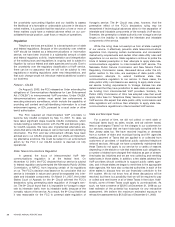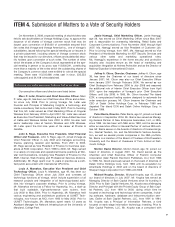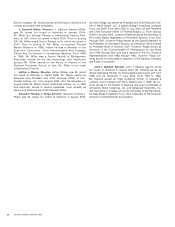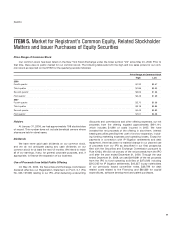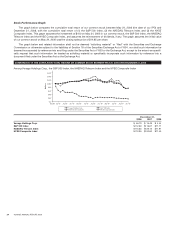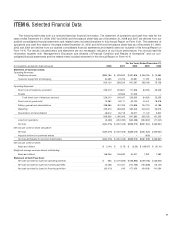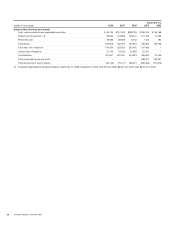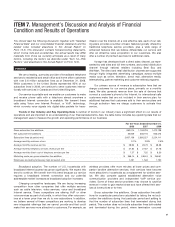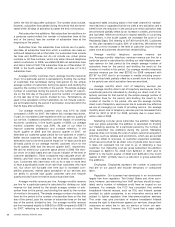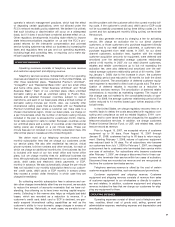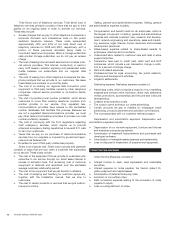Vonage 2008 Annual Report Download - page 28
Download and view the complete annual report
Please find page 28 of the 2008 Vonage annual report below. You can navigate through the pages in the report by either clicking on the pages listed below, or by using the keyword search tool below to find specific information within the annual report.t
he uncertainty surrounding litigation and our inability to assess
t
he likelihood of a favorable or unfavorable outcome in the abov
e
n
oted matters, it is
p
ossible that the resolution of one or more o
f
t
h
ese
m
a
tt
e
r
s cou
l
d
h
a
v
ea
m
a
t
e
ri
a
l
ad
v
e
r
se effec
t
o
n
ou
r
co
n-
s
olidated financial
p
osition, cash flows or results of o
p
erations.
R
egu
l
at
i
o
n
Telephony services are subject to a broad spectrum of state
and federal re
g
ulations. Because of the uncertainty over whethe
r
VoIP should be treated as a telecommunications or in
f
ormatio
n
s
ervice
,
we have been involved in a substantial amount of state
and federal re
g
ulatory activity. Implementation and interpretation
o
f
the existing laws and regulations is ongoing and is subject t
o
l
itigation by various federal and state agencies and courts. Due t
o
t
he uncertainty over the re
g
ulatory classification of VoIP service
,
t
here can be no assurance that we will not be subject to ne
w
r
egu
l
at
i
ons or ex
i
st
i
ng regu
l
at
i
ons un
d
er new
i
nterpretat
i
ons, an
d
th
at suc
h
c
h
an
g
e wou
ld
not
i
ntro
d
uce mater
i
a
l
a
ddi
t
i
ona
l
costs t
o
our business
.
Federal –
C
ALEA
On August 5, 2005, the FCC released an Order extending th
e
obli
g
ations of
C
ommunications Assistance for Law Enforcemen
t
A
ct (“CALEA”) to interconnected VoIP providers. Under CALEA,
t
elecommunications carriers must assist law en
f
orcement i
n
executin
g
electronic surveillance, which include the capability o
f
p
rovidin
g
call content and call-identi
f
yin
g
in
f
ormation to a local
en
f
orcement agency, or LEA, pursuant to a court order or other
la
wf
u
l
au
th
o
riz
a
ti
o
n.
The FCC required all interconnected VoIP providers t
o
b
ecome full
y
CALEA compliant b
y
Ma
y
14, 2007. To date, w
e
h
ave taken significant steps towards
C
ALEA compliance, whic
h
i
nclude testin
g
a CALEA solution with the FBI and deliverin
g
law-
f
ul CALEA requests. We have also implemented alternative sol-
u
tions that allow
C
ALEA access to call content and call-identifying
i
nformation. The FCC and law enforcement officials have bee
n
advised as to our CALEA progress and our efforts at implement
-
i
ng alternative solutions. We could be subject to an enforcement
action b
y
the F
CC
if our
C
ALEA solution is deemed not full
y
operational.
S
tate Telecommunications Regulation
I
n general, the focus of interconnected VoIP tele-
communications re
g
ulation is at the federal level.
On
November 12, 2004, the FCC declared that our service is subjec
t
t
o federal regulation and preempted the Minnesota Public Utilitie
s
C
ommission, or MPU
C
, from imposin
g
certain of its re
g
ulation
s
on us. The FCC’s decision was based on its conclusion that our
s
ervice is interstate in nature and cannot be se
p
arated into inter
-
s
tate and intrastate com
p
onents.
O
n March 21, 2007, the Unite
d
States Court of Appeals for the
8
th
Circuit affirmed the FCC’
s
declaratory ruling preempting state regulation of Vonage’s serv-
ice
.
The 8
t
h
C
ircuit found that it is impossible for Vona
g
e to sepa
-
ra
t
e
it
s
int
e
r
s
t
a
t
e
tr
aff
i
cf
r
o
mit
s
intr
as
t
a
t
e
tr
aff
i
c because of
th
e
n
omadic nature of the service. As a result
,
the
8
th
C
ircuit held that
it was reasonable for the F
CC
to preempt state re
g
ulation o
f
V
ona
g
e’s service. The 8
th
Circuit was clear
,
however
,
that the
p
reemptive effect of the F
CC
’s declaratory ruling may be
reexamined if technolo
g
ical advances allow for the separation of
i
nterstate and intrastate components o
f
the nomadic VoIP service
.
T
herefore, the preemption of state authority over Vonage’s servic
e
hi
n
g
es on t
h
e
i
na
bili
ty to separate t
h
e
i
nterstate an
di
ntrastate
c
omponents o
f
the service
.
W
hile this ruling does not exempt us from all state oversigh
t
o
f our service, it effectivel
y
prevents state telecommunication
s
regulators
f
rom imposing certain burdensome and inconsistent
mar
k
et entry requ
i
rements an
d
certa
i
not
h
er state ut
ili
ty ru
l
es an
d
re
g
ulations on our service.
S
tate re
g
ulators continue to probe th
e
l
imits o
ff
ederal preemption in their attempts to appl
y
state tele
-
c
ommun
i
cat
i
ons regu
l
at
i
on to
i
nterconnecte
dV
o
IP
serv
i
ce.
The
Nebraska Public
S
ervice
C
ommission and New Mexico Public
Regulatory Commission cases, discussed above under the Liti-
g
ation section to this note, are examples of state public utility
c
omm
i
ss
i
on attempts to exten
d
tra
di
t
i
ona
l
state te
l
e
-
c
ommunications regulation to our service. In these cases, th
e
s
tate public utility commissions are seeking to apply state univer-
s
al service fundin
g
requirements to Vona
g
e. Kansas has als
o
d
etermined that the
y
have jurisdiction to seek state universal serv
-
i
ce funding from interconnected VoIP providers.
S
imilarly, th
e
Public Utility
C
ommission of
O
hio has adopted rules that would
a
ppl
y
state fees for Telephone Rela
y
Service to interconnecte
d
V
oIP service. We expect that state public utility commissions and
s
tate
l
e
gi
s
l
ators w
ill
cont
i
nue t
h
e
i
r attempts to app
l
y state te
l
e
-
c
ommunications re
g
ulations to interconnected VoIP service
.
S
tate and Munici
p
al Taxe
s
For a period o
f
time, we did not collect or remit state or
munici
p
al taxes
(
such as sales, excise, and ad valorem taxes
)
,
fees or surchar
g
es
(
“Taxes”
)
on the char
g
es to our customers fo
r
o
ur services, except that we have historicall
y
complied with th
e
New Jersey sales tax. We have received inquiries or demand
s
from a number of state and municipal taxin
g
and 911 a
g
encie
s
s
eekin
g
payment o
f
Taxes that are applied to or collected
f
ro
m
c
ustomers o
fp
roviders o
f
traditional
p
ublic switched tele
p
hon
e
networ
k
serv
i
ces.
Al
t
h
ou
gh
we
h
ave cons
i
stent
l
yma
i
nta
i
ne
d
t
h
at
these Taxes do not appl
y
to our service
f
or a variet
y
o
f
reason
s
d
epending on the statute or rule that establishes such obligations,
a
number of states have chan
g
ed their statutes as part of stream-
l
ined sales tax initiatives and we are now collectin
g
and remittin
g
s
ales taxes in those states. In addition
,
a
f
ew states address ho
w
V
oIP providers should contribute to support public safety a
g
en-
c
ies, and in those states we be
g
an to remit
f
ees to the appropriat
e
s
tate agencies. We have also contacted authorities in each o
f
the
o
ther states to discuss how we can financially contribute to th
e
9
11 s
y
stem. We do not know how all these discussions will b
e
resolved, but there is a possibility that we will be required to pa
y
o
r
co
ll
ec
t
a
n
d
r
e
mit
so
m
eo
r
a
ll
o
fth
ese
T
a
x
es
in th
e
f
u
t
u
r
e
.A
dd
i-
tionall
y
, some o
f
these Taxes could appl
y
to us retroactivel
y
.As
s
uch
,
we have a reserve of
$
2
,
915 at December 31
,
2008 as ou
r
b
est estimate of the potential tax exposure for any retroactiv
e
a
ssessment. We believe the maximum estimated exposure
f
o
r
retroactive assessments is
$
12
,
056 as of December 31
,
2008
.
20
VO
NA
G
E ANN
U
AL REP
O
RT 2008


